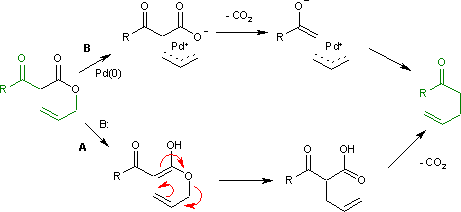Top Qs
Timeline
Chat
Perspective
Carroll rearrangement
Chemical reaction From Wikipedia, the free encyclopedia
Remove ads
The Carroll rearrangement is a rearrangement reaction in organic chemistry and involves the transformation of a β-keto allyl ester into a α-allyl-β-ketocarboxylic acid.[1] This organic reaction is accompanied by decarboxylation and the final product is a γ,δ-allylketone. The Carroll rearrangement is an adaptation of the Claisen rearrangement and effectively a decarboxylative allylation.
The Carroll rearrangement (1940) in the presence of base and with high reaction temperature (path A) takes place through an intermediate enol which then rearranges in a sigmatropic Claisen rearrangement. The follow-up is a decarboxylation. This rearrangement is used in the conversion of linalool to geranylacetone.[2]

Remove ads
Palladium-catalyzed processes
With palladium(0) as a catalyst, the reaction (Tsuji, 1980) is much milder (path B) with an intermediate allyl cation / carboxylate organometallic complex.[3]

Decarboxylation precedes allylation as evidenced by this reaction catalyzed by tetrakis(triphenylphosphine)palladium(0):[4]

Asymmetric decarboxylative allylation
By introducing suitable chiral ligands, the reaction becomes enantioselective.[5]
The first reported asymmetric rearrangement is catalyzed by tris(dibenzylideneacetone)dipalladium(0) and the Trost ligand:[4]

A similar reaction[6] uses additional naphthol.

This reaction delivers the main enantiomer with 88% enantiomeric excess. It remains to be seen if this reaction will have a wide scope because the acetamido group appears to be a prerequisite.
The same catalyst but a different ligand is employed in this enantioconvergent reaction:[7]

The scope is extended to asymmetric α-alkylation of ketones masked as their enol carbonate esters:[8]

Remove ads
References
Wikiwand - on
Seamless Wikipedia browsing. On steroids.
Remove ads